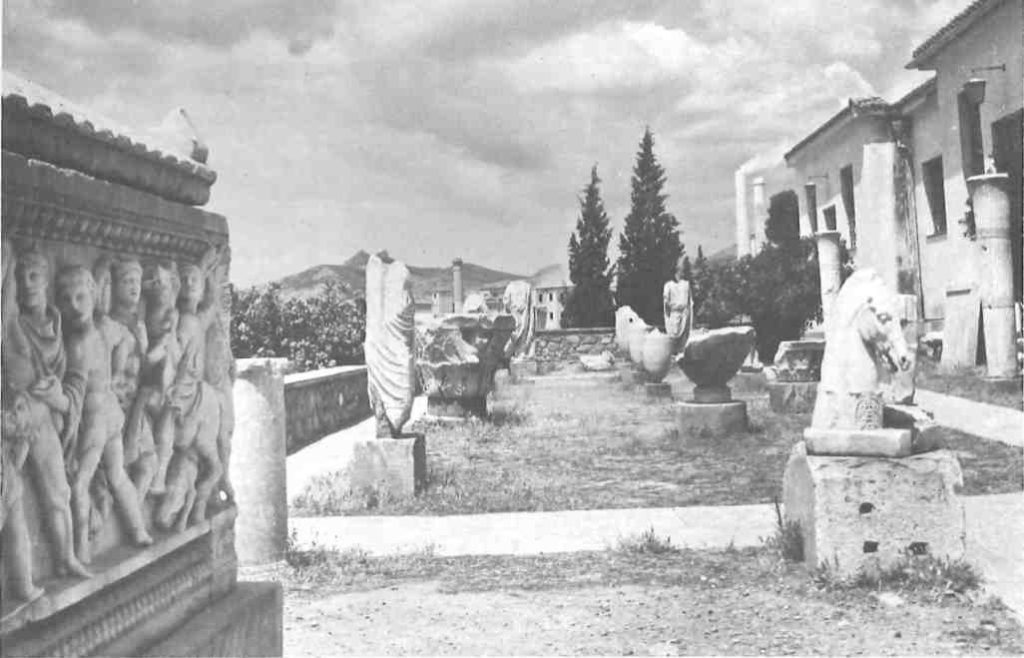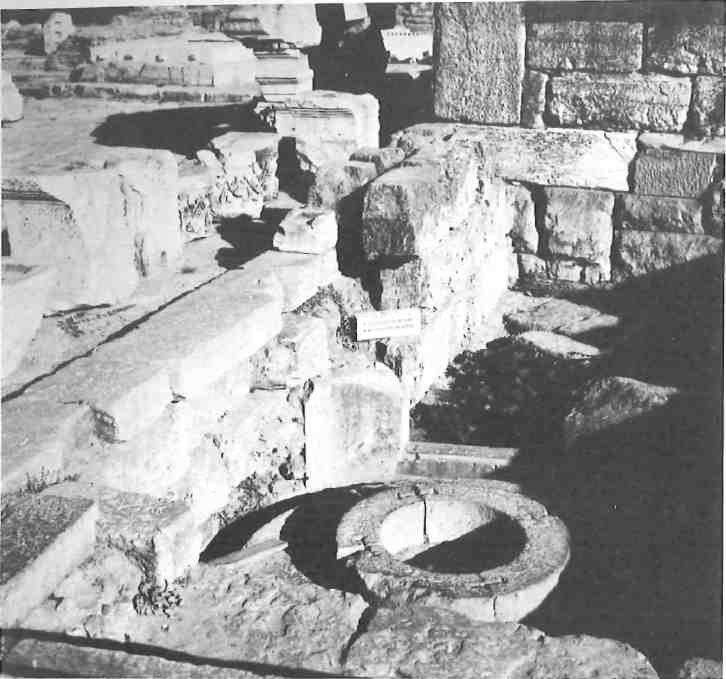Eleusis, fourteen miles west of Athens, is not today a scene of beauty or easy enlightenment: the industry that has risen up around it, and the clutter of ancient ruins are hard to disentangle. But for 2,000 years it was one of the great sites of the Greek world, and its contribution to the shaping of the Greek mind was certainly of immense significance.

National Tourist Organisation of Greece.
The story of its foundation as a religious centre is preserved in the Homeric Hymn to Demeter recorded, perhaps, around 600 B.C.
To Eleusis came Demeter, disguised as an old woman and distraught over the loss of her daughter, Persephone, who had been carried off by Pluto, the god of the underworld. The daughters of the King of Eleusis found her sitting beside the Kallichoron Well. She was hospitably received into the royal household where she took care of the Queen’s infant son.
Eventually she was compelled to reveal her identity and commanded that a temple be built beneath the citadel to house her. This was done and Demeter retired to the temple. The other gods did not help in search for her daughter with the result that grain ceased to grow and famine threatened, as she was the goddess of the fertility of the earth. She announced that she would stay in retreat until again ‘she beheld with her eyes her own sweet-faced daughter’.
Zeus took pity upon her, or found himself compelled by the circumstances to give in, and ordered Persephone to be allowed to return to her mother for two-thirds of every year. The months when Persephone disappeared into Hades to her husband, Pluto, are the four hot summer months when all vegetation has dried up and the earth is bare and parched. Her reappearance is feted in October when, with the first autumn rains, the earth is sprouting green again.
Before leaving with her daughter for Mount Olympus, Demeter initiated the King of Eleusis’ son, Triptolemos, in the sowing of wheat. This led to Triptolemos spreading knowledge of the cultivation of grain all over the world.
We shall never completely know how the rites and mysteries held at Eleusis were conducted. It is said that it is still the ‘best-kept secret in the world’. Aeschylus and Alcibiades, among many others, were accused of revealing part of the secret rites performed at Eleusis and were severely condemned and punished for their indiscretion.
What we do know, however, is that these rites brought the initiate into personal relationship with the goddess and probably ensured some sort of preferential treatment in the after-life.
In antiquity, the procession to the festival, held in October, began at the Dipylon Gate, the chief gateway of ancient Athens, and wound its way along the Sacred Road toward Eleusis.

Today, we meet that same road at Daphni. Pausanias states clearly that, on this spot there stood a sanctuary of Demeter and Persephone, and was one of the halts of the procession along the long road leading to Eleusis. Further along the Sacred Road, we come to the Sanctuary of Aphrodite, a high rock hollowed out in several places to form niches where lovers and worshippers left statuettes, votive offerings and dedications. Next, as the road turns by the sea, the lake, Rheitoi, also dedicated to Demeter and Persephone, comes into view. The lake’s not-so-palatable fish, mostly eels, were the exclusive property of the priests of Eleusis. It was here that the long procession of pilgrims used to assemble before moving on to celebrate the Festivals. Taking the old road to Eleusis, we at last reach the Sacred Site itself, Most of the buildings are supposed to have been constructed between 560 and 440 B.C. at the time of Pisistratus, Kimon and Pericles. The Roman Emperors added to these and some of the magnificient ornate remains are there today, lying on the ground.
Upon arrival, we first reach a large paved courtyard, an assembly spot for the pilgrims. On the left, where the Sacred Road ends, are the ruins of a fountain-house where the pilgrims used to proceed to their ablutions — the washing of their bodies — before entering the Holy Enclosure. Opposite are two magnificent arches and, at the left of this courtyard on a lower, archaic level, we can still see the Kallichoron Well, where the maidens of Eleusis performed their ritual dances. We then walk through the Grand Propylae, but only when we pass through the older, smaller ones, do we enter the Sanctuary proper. A little further on we pass The Agelastos Petra, or Rock of Tears, where Demeter sat and cried for her daughter. The surrounding wall is from the time of Pisistratus. Between it and the external wall of a later date, are the remains of various ‘silos’ for grain. On the right of the small Propylae lies a sanctuary dedicated to Pluto — Hades — with a grotto symbolising the entrance to the underworld.
Walking straight ahead we reach the Great Temple of Demeter of Telester-ion. The remains of this huge temple date from the time of Ictinus, the architect of the Parthenon who made the plans for its construction. This Telesterion, Chamber of Initiation, was the main temple of Eleusis, the ultimate goal of the long processions and preparations for the Great Mysteries. Above it is the Hill of the Acropolis where the ancient city of Eleusis stood and which has yet to be completely excavated. (It is topped today by a rather hideous electric clock, the gift of an Eleusinian politician.)
Walking on a little further, we reach the Museum which houses the finds of the site. Some of the exhibits are very noteworthy and go as far back as the Mycenean and early archaic periods. Among these is a large pitcher which shows Ulysses blinding the Cyclops.
One of the best examples of Greek bas-relief shows how Triptolemos learned the art of sowing wheat from Demeter. Look for the statue of Demeter, presumably by Agorakritos, a pupil of Phidias. Amongst the Roman exhibits is a fine statue of Hadrian’s melancholy favourite, Antinous. A comparatively later discovery is a bronze urn which contained a piece of woolen material, a rare find. This bit of woven stuff can be seen in a frame on the wall over the urn. Also to be admired are numerous decorative sculptures belonging to the buildings of the Sanctuary.
Retracing our steps, we look back with awe and reverence on this all-important site of ancient worship. Jealously guarded in antiquity by the encircling high walls, today it offers itself to the view of all. It is no longer only accessible to the initiates!
The surrounding landscape has been brutally tampered with by man. A few years ago, on a visit to Eleusis my eyes met the high, disfiguring chimney-stacks of a cement factory pouring out its dusty smoke over the sacred ruins. I turned to a friend walking by my side and expressed the wish that I might be granted the power of a dictator — for only one day. I would order that the surrounding cement factories be blown up!
‘So would I, retorted my friend, ‘but they happen to be my husband’s!’
One must make an effort to allow the imagination and the senses to be tuned in only to the divine aspects, abstracting them from the surrounding area. The ancient mystery still emanates from the ruins of Eleusis.







